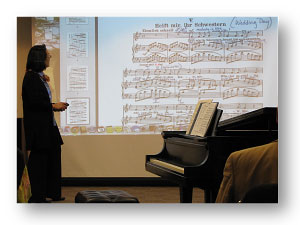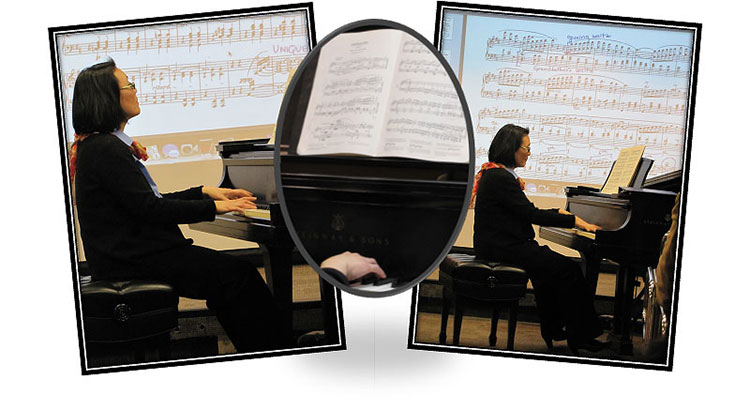Music Educators Association of New Jersey
Serving teachers and students since 1927



"Schumann's Papillons and its Relationship to Lieder" was presented on February 19th by Professor Mia Chung-Yee, a prize winning performing artist currently serving on the Interpretive Analysis faculty of the Curtis Institute.
 Dr. Mia Chung-Yee began with telling of Schumann's life, continued with a fascinating analysis of Frauenliebe und Leben, Op.42, then examined Papillons, Op. 2, and concluded with a performance of Papillons. In a musical world dominated by Beethoven, emerging composers like Chopin, Liszt, Mendelssohn, Schubert, and Schumann would turn to composing in smaller forms. Schumann distinguished himself by writing large works comprised of small pieces. Dr. Chung would explain how Schumann "created cohesion" in such a collection.
Dr. Mia Chung-Yee began with telling of Schumann's life, continued with a fascinating analysis of Frauenliebe und Leben, Op.42, then examined Papillons, Op. 2, and concluded with a performance of Papillons. In a musical world dominated by Beethoven, emerging composers like Chopin, Liszt, Mendelssohn, Schubert, and Schumann would turn to composing in smaller forms. Schumann distinguished himself by writing large works comprised of small pieces. Dr. Chung would explain how Schumann "created cohesion" in such a collection.
The son of a bookseller, Schumann had a lifelong passion for literature and poetry that was expressed in his Lieder and in his many literary references in his piano works. Dr. Chung speculated that the composer's "bipolar" personality contributed to the erratic character and vibrant rhythmic features of some of his music and noted the compositional difficulties of making transitions from those exuberant, exciting phrases to calmer passages. She outlined Schumann's youth and young adulthood: his abhorrence of the study of law which he was pressured to pursue, his becoming a student of Friedrich Wieck, his boarding at the Wieck's, the romance of Robert and Clara, (over nine years younger), and Schumann's series of physical and mental health issues.
 Frauenliebe und Leben, Op.42, (Woman's Love and Life, poetry by Chamisso), is a set of eight songs expressing the thoughts of a woman as she enters successive stages of life, from first attraction and elation, to engagement, marriage, pregnancy, motherhood, and widowhood. In the first song, the opening progression, I IV V7 I in B flat, is repeated at its end. This same progression recurs, expanded or modified, throughout the cycle, and in its original form at the very end of the last song. The final song also repeats parts of other phrases in the cycle, binding the songs together. Dr. Chung also noted that while Schumann begins the fourth song, Du Ring an meinem Finger, on the third scale step by design, emphasizing the special step of betrothal, he starts all of the others on the fifth step, a unifying device. The cross-referencing of melodic materials is yet another unifying device. For example, returning to the original key of B flat in the fifth song, following songs in other "flat" keys, the "bride" sings musical quotations from the first song.
Frauenliebe und Leben, Op.42, (Woman's Love and Life, poetry by Chamisso), is a set of eight songs expressing the thoughts of a woman as she enters successive stages of life, from first attraction and elation, to engagement, marriage, pregnancy, motherhood, and widowhood. In the first song, the opening progression, I IV V7 I in B flat, is repeated at its end. This same progression recurs, expanded or modified, throughout the cycle, and in its original form at the very end of the last song. The final song also repeats parts of other phrases in the cycle, binding the songs together. Dr. Chung also noted that while Schumann begins the fourth song, Du Ring an meinem Finger, on the third scale step by design, emphasizing the special step of betrothal, he starts all of the others on the fifth step, a unifying device. The cross-referencing of melodic materials is yet another unifying device. For example, returning to the original key of B flat in the fifth song, following songs in other "flat" keys, the "bride" sings musical quotations from the first song.
 Attention was drawn to the elements that convey the changing moods. For example, dance-like rhythms evoke happiness, and more chromatic passages suggest pensiveness. The accompaniment varies, at times sitting lower than the voice, then rising above it, doubling the vocal line or not, varying in texture from song to song. Schumann assigns a powerful role to the piano when he uses it without the voice in critical interludes within the songs and at expressive introductions and endings. Modality also colors moods; all but the sixth and seventh songs, in G and C, are in the "flat keys." The final song, an adagio, opens in D minor, moves poco a poco diminuendo to a fermata on the dominant A. The vocal part ends, but the piano continues; the bass descends to F, an E drops to E flat, and an A in an upper voice becomes the leading tone to B flat, a chromatic bridge to the short reprise of the first song.
Attention was drawn to the elements that convey the changing moods. For example, dance-like rhythms evoke happiness, and more chromatic passages suggest pensiveness. The accompaniment varies, at times sitting lower than the voice, then rising above it, doubling the vocal line or not, varying in texture from song to song. Schumann assigns a powerful role to the piano when he uses it without the voice in critical interludes within the songs and at expressive introductions and endings. Modality also colors moods; all but the sixth and seventh songs, in G and C, are in the "flat keys." The final song, an adagio, opens in D minor, moves poco a poco diminuendo to a fermata on the dominant A. The vocal part ends, but the piano continues; the bass descends to F, an E drops to E flat, and an A in an upper voice becomes the leading tone to B flat, a chromatic bridge to the short reprise of the first song.
Schumann discovered these unifying principles at the piano! Dr. Chung turned to Papillons, ("social" Butterflies), a collection of twelve dancelike pieces, all in triple meter excepting No. 2. Perhaps inspired by Jean Paul Richter's Flegeljahre, (Adolescent Years), Papillons open with a fanfare, an ascending arpeggio modified by neighbor notes emphasizing the interval of the fourth. This leap of the fourth becomes a principal unifying element as it is reiterated in the successive dances. Another unifying feature is the repetition of a curving contour of a rising and falling melodic line introduced in No. 1. In addition, as in the Lieder, material from one piece was reworked or paraphrased in another. The Finale, No. 12, uses the "Grandfather's Waltz," a popular Viennese melody signaling the last dance at a ball, followed by the return of the opening waltz. A long diminuendo, a thinning of texture, a pedal point on the tonic against the repeated high note chiming the late hour and a novel sustained chord of disappearing tones bring this work to a close.

Dr. Chung then performed the entire Papillons. Her beautiful playing, her analysis and observations certainly deepened our understanding of these compositions and provided another way to approach pieces of this genre.
 Time constraints limited Ana Berschadsky, hostess, to mentioning only a few of Dr. Mia Chung-Yee's impressive accomplishments. A former member of the Lincoln Center Chamber Music Society II, Mia Chung-Yee has played solo and chamber music recitals and piano concertos in major concert halls in the United States and internationally. In addition, she has participated in NPR broadcasts. Her recordings, particularly of Schumann, have been well received. For more see http://www.miachung.com/bio.htm.
Time constraints limited Ana Berschadsky, hostess, to mentioning only a few of Dr. Mia Chung-Yee's impressive accomplishments. A former member of the Lincoln Center Chamber Music Society II, Mia Chung-Yee has played solo and chamber music recitals and piano concertos in major concert halls in the United States and internationally. In addition, she has participated in NPR broadcasts. Her recordings, particularly of Schumann, have been well received. For more see http://www.miachung.com/bio.htm.
Critics had described Mia Chung's playing as "dazzling and insightful," words that surely describe her presentation to the MEA audience.
Written by Senior Editor, Bertha Mandel
Photography and layout, Nancy Modell
Hostess Ana Berschadsky